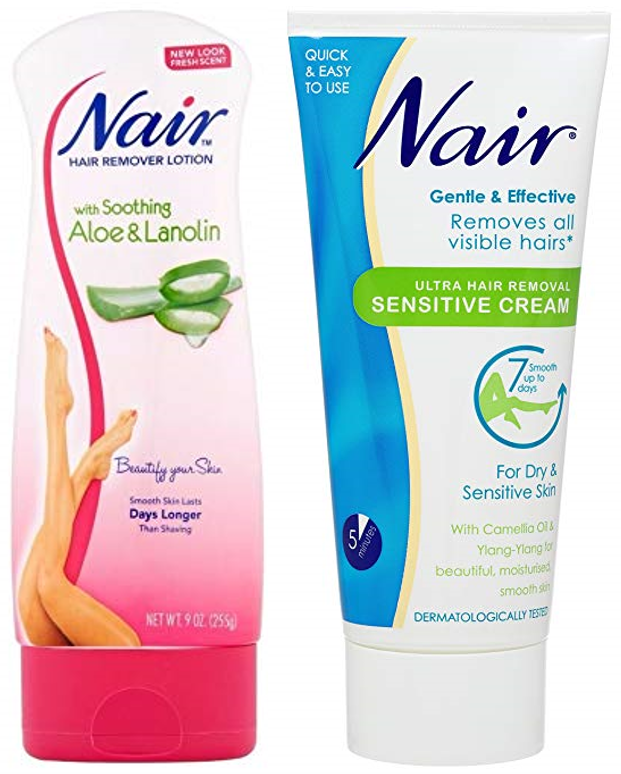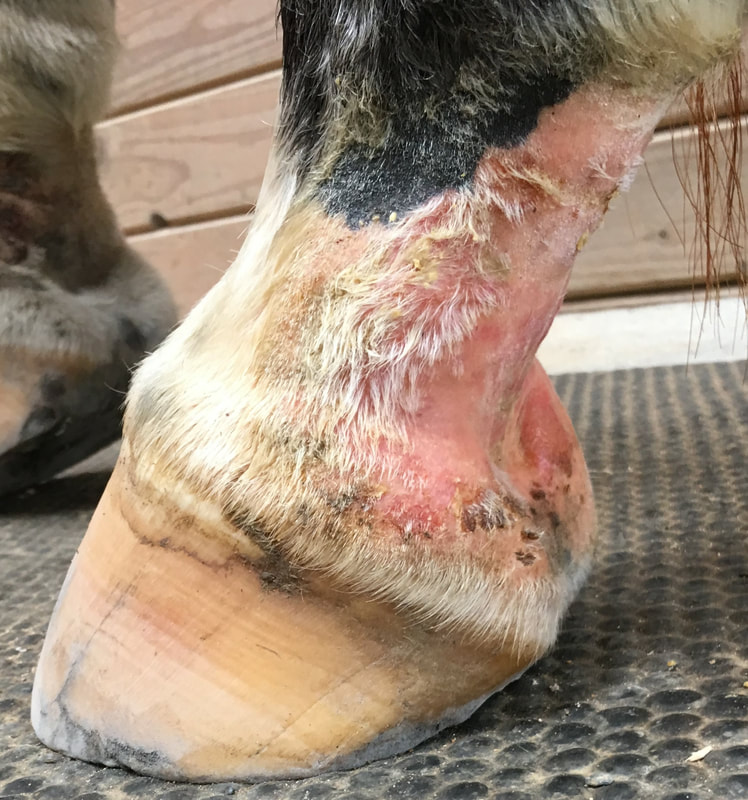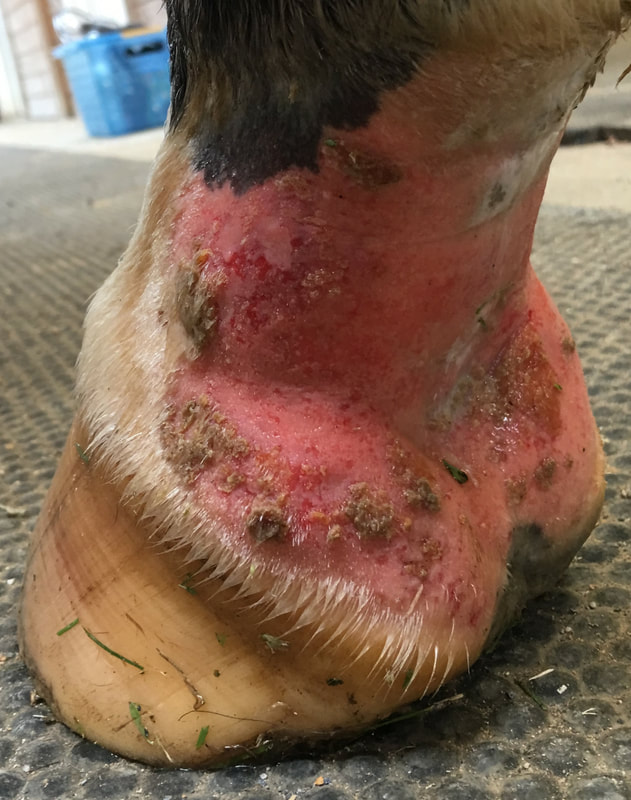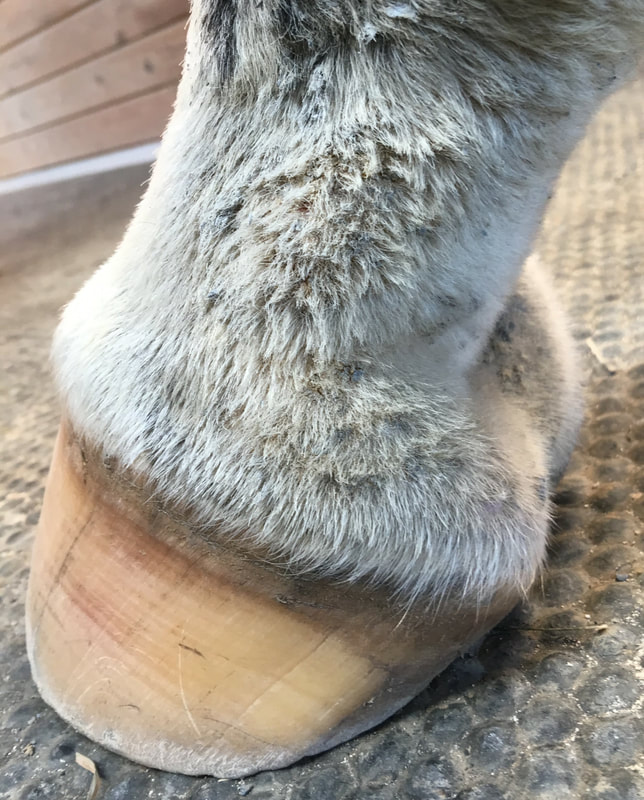JANUARY 6, 2019 - TIP OF THE DAY (TOD)
The following "Tip of the Day" is provided to assist you with horse and farm management. It is an idea used by Leslie Raulin. This tip is available to you at your own risk. Leslie Raulin does not make any claims or warranties nor does she have any financial interest in any products that may be mentioned. Additionally, this TOD provides information on the treatment of an equine medical condition; I am not professing to practice veterinary medicine, I am just letting you know what I do.
HORSE SCRATCHES
There are probably as many articles (and theories) on scratches as there are horses with scratches. With this TOD I am not professing to be an expert and am not telling you how to treat your horses; I am simply summarizing my interpretation and thoughts based on my reading and my experiences treating scratches in one of my horses.
*** WHAT IS SCRATCHES? ***
Scratches is the most common term for equine pastern dermatitis. It is also commonly called mud fever, greasy heel, dew poisoning, and cracked heels.
According to The Merck Veterinary Manual, "Scratches is a chronic, seborrheic (flaky skin) dermatitis characterized by hypertrophy (enlargement of the skin cells) and exudation (oozing) on the caudal (rear) surface of the pastern and fetlock. It often is associated with poor stable hygiene, but no specific cause is known. Heavy horses are particularly susceptible (potentially because their feathered legs can trap dirt and moisture), and the hind limbs are affected more commonly.”
Dermatitis is an inflammatory condition of the skin caused by infections, allergies, and irritating substances. There are many types of dermatitis.
Scratches is usually found on the pastern of the horse, but may travel up the leg. It is usually found on horses with pink skin (white hair) at the pasterns; however, it can be found on areas with dark skin (dark hair). It is also more common on horses with feathers (long lower leg hair).
Horses are usually afflicted with scratches in the spring and summer when the weather is warm, humid, and rainy (resulting in muddy conditions).
In advanced untreated cases, scratches can result in a serious deep infection that is very painful and incapacitating for the horse. On occasion, scratches can become so severe that systemic antibiotics are needed.
According to The Merck Veterinary Manual, "Scratches is a chronic, seborrheic (flaky skin) dermatitis characterized by hypertrophy (enlargement of the skin cells) and exudation (oozing) on the caudal (rear) surface of the pastern and fetlock. It often is associated with poor stable hygiene, but no specific cause is known. Heavy horses are particularly susceptible (potentially because their feathered legs can trap dirt and moisture), and the hind limbs are affected more commonly.”
Dermatitis is an inflammatory condition of the skin caused by infections, allergies, and irritating substances. There are many types of dermatitis.
Scratches is usually found on the pastern of the horse, but may travel up the leg. It is usually found on horses with pink skin (white hair) at the pasterns; however, it can be found on areas with dark skin (dark hair). It is also more common on horses with feathers (long lower leg hair).
Horses are usually afflicted with scratches in the spring and summer when the weather is warm, humid, and rainy (resulting in muddy conditions).
In advanced untreated cases, scratches can result in a serious deep infection that is very painful and incapacitating for the horse. On occasion, scratches can become so severe that systemic antibiotics are needed.
*** WHAT CAUSES SCRATCHES? ***
There are many theories regarding the cause(s) of scratches; however, no definitive cause has been determined. That said, certain conditions in the environment, microbiota, and the horse are contributing factors. I call this the scratches triad that is key to the development of scratches:
ENVIRONMENT: Scratches is most commonly seen when the weather is warm and humid and the ground is wet and muddy. The environment affects the microbiota and the horse.
MICROBIOTA: Bacteria, fungi, viruses and parasites in the wet and muddy ground, as well as those normally inhabiting the horse skin surface, are able to enter through the wet compromised skin. Microorganisms usually thrive during warm and humid weather so they are more abundant. The ground moisture compromises the skin, making it more vulnerable to invasion by soil microbiota.
HORSE: Not all horses get scratches. Those that do get scratches usually have pink skin and feathers in the afflicted area. Pink skin may be more vulnerable to the affects of moisture and horse feathers increase contact with the mud and moisture, and therefore the microbiota. Affected horses may also have a compromised immune system that results in a hyperactive immune response to their own microbiota and the microbiota in the wet muddy soil. The hyperactive immune response to the invading microbiota destroys tissue, resulting in the lesions of scratches. A hyperactive immune response is also seen in other types of dermatitis, psoriasis, periodontal disease, and many other tissue destructive diseases.
As in the above Venn diagram, the intersection of the triad of factors may lead to scratches.
ENVIRONMENT: Scratches is most commonly seen when the weather is warm and humid and the ground is wet and muddy. The environment affects the microbiota and the horse.
MICROBIOTA: Bacteria, fungi, viruses and parasites in the wet and muddy ground, as well as those normally inhabiting the horse skin surface, are able to enter through the wet compromised skin. Microorganisms usually thrive during warm and humid weather so they are more abundant. The ground moisture compromises the skin, making it more vulnerable to invasion by soil microbiota.
HORSE: Not all horses get scratches. Those that do get scratches usually have pink skin and feathers in the afflicted area. Pink skin may be more vulnerable to the affects of moisture and horse feathers increase contact with the mud and moisture, and therefore the microbiota. Affected horses may also have a compromised immune system that results in a hyperactive immune response to their own microbiota and the microbiota in the wet muddy soil. The hyperactive immune response to the invading microbiota destroys tissue, resulting in the lesions of scratches. A hyperactive immune response is also seen in other types of dermatitis, psoriasis, periodontal disease, and many other tissue destructive diseases.
As in the above Venn diagram, the intersection of the triad of factors may lead to scratches.
*** MULTI-AGENT PASTE FOR THE TREATMENT OF SCRATCHES ***
There are many products to treat scratches. An internet search will produce many articles, videos and product advertisements. Treatment methods include topical antimicrobial agents, topical anti-inflammatory agents, various physical "barriers" (commercial stockings and wraps, etc.), various creams and powders to keep the skin dry, various combination creams or ointments, etc. I recommend you conduct an internet search as excellent information is available. The following is what I have used to treat scratches, based on my internet searches and the scratches triad.
COMPOSITION OF THE MULTI-AGENT PASTE FOR SCRATCHES
ZINC OXIDE PASTE: Commonly known as Desitin, this is the same paste used to treat diaper rash (another type of dermatitis). It is very adherent to the skin and thereby helps keep moisture from the skin. Zinc oxide paste therefore assists in controlling the environment (wet) aspect of the scratches triad.
TRIPLE ANTIBIOTIC OINTMENT: This ointment contains:
Bacitracin Zinc: Active against gram-positive bacteria such as staph and strep, especially those in skin infections.
Neomycin Sulfate: Active against gram-negative bacteria and some gram-positives.
Polymyxin B Sulfate: Active against gram-negative bacteria.
Triple antibiotic ointment therefore assists in controlling the microbiota (bacteria) aspect of the scratches triad.
MICONAZOLE CREAM: Active against fungi. Miconazole therefore assists in controlling the microbiota (fungi) aspect of the scratches triad.
HYDROCORTISONE 1% CREAM: This is an anti-inflammatory cream used topically to treat inflammatory skin conditions. Hydrocortisone 1% cream therefore assists in controlling the horse hyperactive immune response aspect of the scratches triad.
TRIPLE ANTIBIOTIC OINTMENT: This ointment contains:
Bacitracin Zinc: Active against gram-positive bacteria such as staph and strep, especially those in skin infections.
Neomycin Sulfate: Active against gram-negative bacteria and some gram-positives.
Polymyxin B Sulfate: Active against gram-negative bacteria.
Triple antibiotic ointment therefore assists in controlling the microbiota (bacteria) aspect of the scratches triad.
MICONAZOLE CREAM: Active against fungi. Miconazole therefore assists in controlling the microbiota (fungi) aspect of the scratches triad.
HYDROCORTISONE 1% CREAM: This is an anti-inflammatory cream used topically to treat inflammatory skin conditions. Hydrocortisone 1% cream therefore assists in controlling the horse hyperactive immune response aspect of the scratches triad.
These products are available over-the-counter at grocery and drug stores and online. I purchased them via Amazon.com for the following costs: Desitin $2.69 per 4oz tube, Triple Antibiotic Ointment $4.00 per 1oz tube, Miconazole $3.25 per 1oz tube, and Hydrocortisone 1% $3.05 per 2oz tube, for a total of $12.99.
PREPARATION OF THE MULTI-AGENT PASTE FOR SCRATCHES
** PREPARATION OF THE HORSE - REMOVE HAIR IN SCRATCHES AREA(S) **
This step addresses the horse (feathers) aspect of the triad. It also exposes the skin for maximal contact with the multi-agent paste.
|
This step may be controversial but has worked for me. Instead of clipping the scratches area, I have been using Nair hair removal lotion/cream. In my hands, on my horse, the first use (when there is still lots of hair present), I apply the Nair for 5 minutes then wash off thoroughly. For subsequent uses, when the hair starts to grow back, I apply the Nair for 3-4 minutes then wash off thoroughly. If you leave the Nair on for too long, you can scald the horse's skin (see photo below), so you need to be extremely vigilant. It is a good idea to first treat a small section of the pastern to determine the correct treatment time for your horse. I have used regular Nair with Aloe and Lanolin. I recently purchased Nair for Sensitive Skin but have not yet used it yet. |
|
This is Annie after using Nair the first time, rinsing, and drying. Annie is 23 years old, has Cushing's disease, and is treated with Regumate, and takes Equioxx for arthritis. Therefore, her immune system is compromised, making her more prone to scratches and other infectious conditions. At this point, some people recommend removal of the scab. I do not recommend this as it is painful for the horse and the scab "dissolves" during the treatment described below. |
*** APPLICATION OF THE PASTE AND WRAP ***
|
Lastly, wrap with vet wrap. I also use a strip of Elasticon to ensure the vet wrap does not unwrap. I usually leave the wrap on for two days before replacing it. Update 31 Mar 2019 - I have started using puppy pads and vet wrap w elasticon strip as the only wrap. The puppy pads have absorbent and plastic sides so you get a two-in-one. This approach is easier, cheaper, and effective. |
*** FOLLOW UP PHOTOS ***
|
OUCH!!!!!! Poor Annie. September 12, 2018. Re-treated with 5-minutes of Nair as hair was growing back. Scald from leaving Nair on too long. This is when I learned that re-application of Nair needs less time, 3-4 minutes maximum. There is also return of scratches scabs. I should have applied the paste and re-wrapped; however, I only applied paste. |
|
October 5, 2018. I would like to say the treatment totally eliminated Annie's scratches; however, this did not happen. Since early treatment with paste and wrap looked so successful, I think if I had kept wraps on for a longer period of time the results might have been better. But her condition has improved, which is good for this older mare with medical complications. For a horse like Annie (old, Cushings, Regumate, Equioxx), her scratches condition is most likely an incurable chronic condition, much like periodontal disease. It needs to be monitored closely, have recurring treatment, and have more intensive treatment if the condition worsens. |
For summer 2019, Annie the multi-agent paste was applied at least once a week. She developed very few and very small areas of scratches.
AVIANI
27 March 1995 - 26 September 2019
Rest in peace noble Annie. You were an extraordinary teacher and an honorable companion.
27 March 1995 - 26 September 2019
Rest in peace noble Annie. You were an extraordinary teacher and an honorable companion.
















































